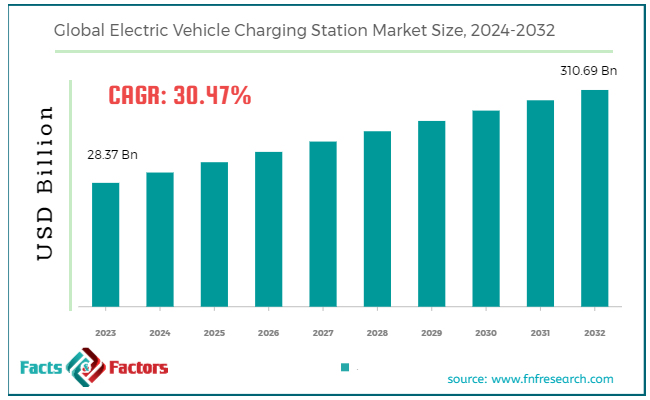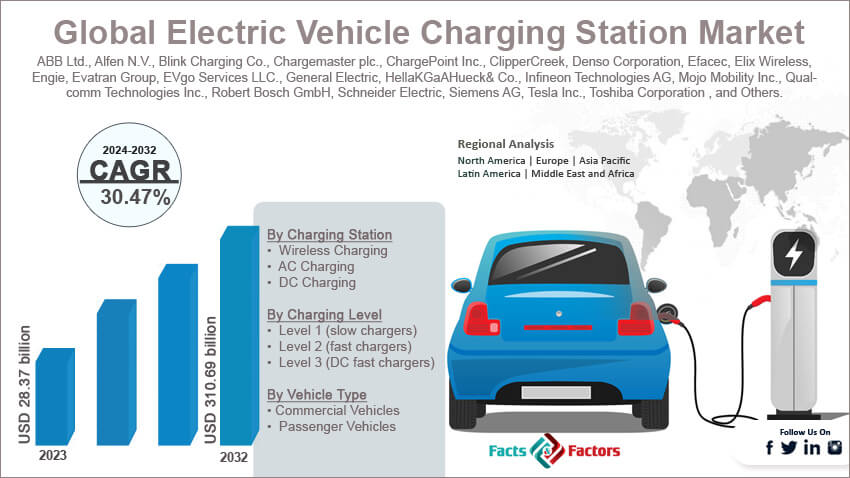 en
en  en
en  en
en  en
en 
[213+ Pages Report] According to Facts & Factors, the global electric vehicle charging station market size in terms of revenue was valued at around USD 28.37 billion in 2023 and is expected to reach a value of USD 310.69 billion by 2032, growing at a CAGR of roughly 30.47% from 2024 to 2032. The global electric vehicle charging station market is projected to grow at a significant growth rate due to several driving factors.

 Market Overview
Market OverviewAn electric vehicle (EV) charging station, also known as an EV charger or EVSE (Electric Vehicle Supply Equipment), is a piece of equipment that supplies electric energy for recharging electric vehicles, including electric cars, plug-in hybrids, and other electric vehicles. These stations can be installed in residential, commercial, and public locations, providing different levels of charging speed depending on the type of charger used. Charging stations are crucial for the adoption and operation of electric vehicles, ensuring that drivers can conveniently recharge their vehicles' batteries.
The electric vehicle charging station market is experiencing rapid growth due to the increasing adoption of electric vehicles, government initiatives to reduce carbon emissions, and advancements in charging technology. The market encompasses various types of chargers, including slow chargers (Level 1), fast chargers (Level 2), and rapid chargers (Level 3 or DC fast chargers).
 Key Highlights
Key Highlights
 Electric Vehicle Charging Station Market: Growth Drivers
Electric Vehicle Charging Station Market: Growth Drivers Restraints:
Restraints: Opportunities:
Opportunities: Challenges:
Challenges: Electric Vehicle Charging Station Market: Segmentation Analysis
Electric Vehicle Charging Station Market: Segmentation AnalysisThe global electric vehicle charging station market is segmented based on charging station, charging level, vehicle type, end-user, and region.
 By Charging Station Insights
By Charging Station InsightsBased on Charging Stations, the global electric vehicle charging station market is divided into wireless charging, AC charging, and DC charging. The wireless charging segment is expected to grow at a moderate CAGR Wireless charging is gaining attention due to its convenience and ease of use. This technology eliminates the hassle of plugging in cables and provides a seamless charging experience. It is particularly beneficial for autonomous vehicles and public charging infrastructure. However, the adoption of wireless charging is currently limited by higher costs and lower efficiency compared to wired charging methods.
The AC charging segment is projected to grow steadily, driven by the increasing number of residential installations and the development of public charging infrastructure. The segment is expected to maintain a significant market share due to its cost-effectiveness and widespread application?.
The DC charging segment accounted for 74.3% of revenue share in 2023. This segment is expected to grow at the highest CAGR, driven by the increasing need for fast and efficient charging solutions. The expansion of high-power charging networks and supportive government policies promoting the installation of fast chargers will further boost the market growth. This segment is anticipated to dominate the market due to its ability to meet the quick charging demands of EV users?.
 By Charging Level Insights
By Charging Level InsightsOn the basis of Charging Level, the global electric vehicle charging station market is bifurcated into level 1, level 2, and level 3. Level 1 charging refers to the most basic form of electric vehicle (EV) charging, using a standard household outlet (120V in North America). The Level 1 charging segment is expected to grow steadily, driven by the increasing adoption of electric vehicles and the need for basic, cost-effective charging solutions for residential use. While it may not see explosive growth compared to faster charging options, Level 1 charging will remain an essential part of the EV charging infrastructure due to its accessibility and ease of use??.
Level 2 segment has held a market share of around 72.4% in 2023. Level 2 charging involves the use of a 240V outlet (or 208V in commercial settings), offering faster charging speeds compared to Level 1. The Level 2 charging segment is expected to dominate the market with a significant CAGR, driven by increasing EV adoption, supportive government policies, and the expansion of public and workplace charging infrastructure. Continuous advancements in charging technology and the integration of smart charging features will further enhance the growth of this segment.
Level 3 charging, also known as DC fast charging, uses direct current (DC) to charge vehicles quickly. These chargers can provide up to 350 kW of power, adding 60 to 100 miles of range in just 20 minutes. The Level 3 charging segment is expected to grow at the highest CAGR, supported by increasing investments in fast-charging infrastructure, advancements in charging technology, and government initiatives to promote the adoption of electric vehicles. The expansion of high-power charging networks and the introduction of next-generation ultra-fast chargers will further drive the growth of this segment??.
 By Vehicle Type Insights
By Vehicle Type InsightsBased on Vehicle Type, the global electric vehicle charging station market is categorized into commercial vehicles and passenger vehicles. Commercial vehicles include electric trucks, buses, delivery vans, and other utility vehicles used for business and industrial purposes. The market for EV charging stations catering to commercial vehicles is expected to grow at a significant CAGR. This growth is fueled by government incentives for electric commercial vehicles, increasing investments in high-power charging infrastructure, and the expansion of electric fleets in logistics and public transportation.
The market for EV charging stations for passenger vehicles is projected to grow steadily, with a robust CAGR. The growth is supported by the rising adoption of electric vehicles among consumers, continuous improvements in battery technology, and government policies promoting EV use. The expansion of public charging networks, the development of high-speed chargers, and the integration of smart charging solutions will further enhance the growth of this segment??.
 By End-User Insights
By End-User InsightsBased on End-User, the global electric vehicle charging station market is divided into commercial and residential. Commercial segment has captured a market share of around 67.2% in 2023. Commercial end-users include businesses, public charging stations, retail locations, workplaces, hotels, and parking facilities. The commercial segment is expected to dominate the market with a significant CAGR, driven by the expanding network of public charging stations, increased investments from businesses, and supportive government policies. The development of ultra-fast charging stations and the integration of smart charging solutions are also key factors contributing to the growth of this segment?.
Residential end-users primarily consist of individual homeowners who install EV charging stations at their homes. These charging stations provide the convenience of overnight charging and ensure that electric vehicles are ready for use each day. The residential segment is expected to grow steadily, supported by rising EV adoption rates, advancements in home charging technology, and government incentives. The convenience of home charging and the availability of smart home charging systems that can be integrated with home energy management systems will further drive the growth of this segment?.
 Recent Developments:
Recent Developments: Report Scope
Report ScopeReport Attribute |
Details |
Market Size in 2023 |
USD 28.37 Billion |
Projected Market Size in 2032 |
USD 310.69 Billion |
CAGR Growth Rate |
30.47% CAGR |
Base Year |
2023 |
Forecast Years |
2024-2032 |
Key Market Players |
ABB Ltd., Alfen N.V., Blink Charging Co., Chargemaster plc., ChargePoint Inc., ClipperCreek, Denso Corporation, Efacec, Elix Wireless, Engie, Evatran Group, EVgo Services LLC., General Electric, HellaKGaAHueck& Co., Infineon Technologies AG, Mojo Mobility Inc., Qualcomm Technologies Inc., Robert Bosch GmbH, Schneider Electric, Siemens AG, Tesla Inc., Toshiba Corporation , and Others. |
Key Segment |
By Charging Station, By Charging Level, By Vehicle Type, By End-User, and By Region |
Major Regions Covered |
North America, Europe, Asia Pacific, Latin America, and the Middle East &, Africa |
Purchase Options |
Request customized purchase options to meet your research needs. Explore purchase options |
 Electric Vehicle Charging Station Market: Regional Analysis
Electric Vehicle Charging Station Market: Regional AnalysisThe Asia-Pacific region is anticipated to witness the fastest growth in the electric vehicle charging station market. Countries like China, Japan, South Korea, and India are driving this growth through aggressive expansion of charging infrastructure, government incentives, and rising consumer demand for electric vehicles. China, in particular, leads the region due to its large EV market and substantial investments in charging infrastructure.
North America witnesses moderate growth in the electric vehicle charging station market, driven by substantial investments in infrastructure and strong government incentives. The United States and Canada are leading this growth, with numerous initiatives aimed at expanding the EV charging network and promoting sustainable transportation.
Europe is another major market for electric vehicle charging stations, driven by stringent emission regulations, substantial government subsidies, and the commitment to reduce carbon footprints. Key countries such as Germany, the UK, France, and Norway are at the forefront, with extensive networks of charging stations and strong governmental support.
Latin America is emerging as a growing market for EV charging stations, driven by increasing environmental awareness, supportive government policies, and investments in green infrastructure. Brazil and Mexico are key markets within this region, focusing on expanding their EV charging networks to support growing EV adoption.
The Middle East & Africa region is gradually expanding its electric vehicle charging infrastructure, driven by a growing interest in sustainable energy solutions and governmental initiatives. Countries such as the UAE and South Africa are leading this growth by investing in EV charging stations and promoting the use of electric vehicles.
 Electric Vehicle Charging Station Market: List of Key Players
Electric Vehicle Charging Station Market: List of Key PlayersThe analysis-intensive report provides key insights into companies and organizations operating in the global electric vehicle charging station market. The study further makes a relative examination of the organizations highlighting essential business parameters such as geographic presence, business overviews, product offerings, segment-based market share, operational strategies, and SWOT analysis. Recent enterprise developments including novel product launches, joint ventures, partnerships, strategic alliances, mergers & acquisitions, and product development are elaborated upon in the report. The in-depth study thus facilitates a comprehensive analysis of market competition.
Some of the main competitors dominating the global electric vehicle charging station market include;
The global electric vehicle charging station market is segmented as follows:
 By Charging Station Segment Analysis
By Charging Station Segment Analysis By Charging Level Segment Analysis
By Charging Level Segment Analysis By Vehicle Type Segment Analysis
By Vehicle Type Segment Analysis By End-User Segment Analysis
By End-User Segment Analysis By Regional Segment Analysis
By Regional Segment Analysis

Copyright © 2024 - 2025, All Rights Reserved, Facts and Factors
 en
en  en
en